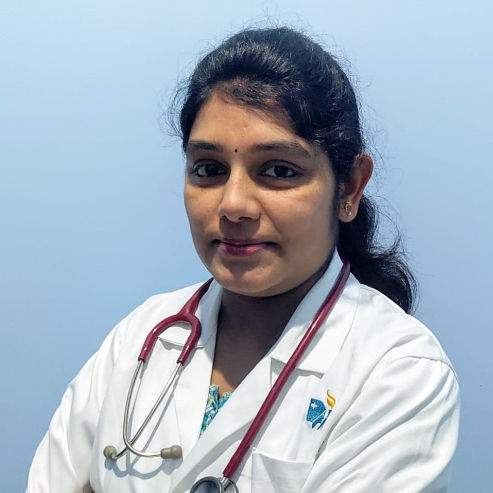How To Reduce Breast Pain Before Period?
Premenstrual breast pain is not a serious issue but needs proper attention. So, know the causes, self-care strategies, and treatment.

Written by
Last updated on 3rd Jul, 2025
Premenstrual breast pain or mastalgia is a common condition where a woman experiences discomfort and tenderness in her breast before her period. The pain feels like heaviness in the breast, soreness or swelling. It disappears naturally after the period ends but returns before the next menstruation cycle. As it is entirely associated with menstruation, it stops after menopause.
The leading cause is the imbalance of oestrogen and progesterone hormones during the menstrual cycle. Otherwise, it can also happen due to stress, poor diet or tight-fitting bras. Sometimes, fibrocystic breasts may be the cause. So, it is wise to consult a doctor if the pain is severe.
Hormonal Fluctuations and Breast Pain
Studies from the American Academy of Family Physicians (AAFP) show that hormonal changes are the primary reason for breast pain before the period. During the luteal phase of the menstrual cycle, the oestrogen level increases, and progesterone levels become low. These changes cause swelling of lymph nodes that further contributes to breast pain.
Additionally, an increase in prolactin levels may lead to breast swelling and tenderness. Prolactin is a hormone that triggers breast milk production in the female body after childbirth. As this hormone is naturally occurring and an essential component of a woman's body, it can affect the breasts even if a woman has not given birth yet.
Identifying Symptoms of Cyclic Breast Pain
There are two types of breast pains – cyclic and non-cyclic pains. Cyclic pains are linked with monthly menstruation. The pain becomes severe before menstrual periods and goes away when the periods end. On the other hand, non cyclical pain may be caused by cysts that are common in people of ages between 30 and 50.
The symptoms of cyclical breast pain are not the same in every woman. Some women experience constant breast pain during periods. For others, it might come and go. Many women feel it as soreness, while others may feel it as tenderness. Other possible symptoms are -
Sharp pain
Acute feeling around the nipple area
Swelling
Pain in underarms
Pain in one or both breasts
However, individuals should consult a doctor if they suffer from any of the following symptoms -
Foul-smelling or bloody nipple discharge from the breast.
A breast pain with lump or multiple lumps.
Experiencing signs of infections like fever, redness or warmth of the breast.
A pain that lasts for more than several weeks.
A pain that creates difficulties in performing regular activities.
Lifestyle Modifications to Alleviate Breast Pain
Lifestyle changes play a massive role in managing premenstrual breast pain. Hence, individuals must consider diet modification. First of all, they should limit or eliminate alcohol, caffeine and foods that contain high amounts of fat and salt. Restricting these foods may help manage the pain as they increase discomfort. They should prioritise a vitamins and minerals-rich diet, which includes foods such as -
Carrots
Peanuts
Brown rice
Spinach
Oat bran
Corn and olive oil
Bananas
Individuals having cyclic breast pain find difficulties in exercising and workouts. However, low-intensity exercises can help prevent this issue. For example, they can participate in yoga, swimming, cycling and Pilates.
Stress management techniques can also help resolve this issue. This includes -
A relaxation therapy that can control high levels of anxiety causing breast pain.
Getting adequate sleep at night.
In some cases, complementary therapies such as acupuncture and aromatherapy.
Over-the-counter and Home Remedies
Over-the-counter (OTC) medications can help with mild symptoms. These include -
Non-steroidal anti-inflammatory drugs (NSAIDs) such as ibuprofen and naproxen sodium.
Trolamine salicylate cream soothes pains and aches.
Also, herbal supplements such as evening primrose oil, may reduce breast pain by balancing the fatty acids in the cells. Furthermore, omega-3 fatty acids, vitamin B6, vitamin E, and magnesium supplements will help to get relief from some of the symptoms of breast pain during periods. One must take the supplement two weeks before the menstrual flow.
Medical Treatments for Severe Pain
However, OTC treatment may not work if the pain is severe. Depending upon the underlying causes of severe breast pain before the period, the healthcare provider prescribes medications. For instance -
Birth control pills for managing hormone fluctuations.
Antibiotics in case of any infection.
Water pills or diuretics are given before the menstrual period to reduce breast tenderness and swelling.
In some rare cases, the doctor may prefer to prescribe a synthetic steroid and pituitary gonadotropin named danazol to reduce the breast pain. However, doctors usually don't recommend it as it has significant side effects. Sometimes, doctors may give progestin hormone (Depo-Provera) injections or shots that work for up to 90 days.
These injections reduce symptoms by pausing the menstrual flow.
Also, hormonal therapies such as bromocriptine, goserelin and tamoxifen can be helpful to treat this issue. Bromocriptine blocks the prolactin hormone in the hypothalamus and tamoxifen blocks oestrogen.
Consult Top Specialists for Personalised Treatment
The Role of Bras in Managing Pain
Bras can cause breast pain if they do not fit well. A bra that is too tight can affect the breast tissue. So, ensuring that the patient wears a well-fitted bra is crucial. Several studies suggest that cyclical breast pain symptoms are reduced by wearing the right bra.
So, here are some tips which will help an individual select the right kind of bras -
Supportive, comfortable and non-wired bras should be bought.
A sports bra should be used for exercise.
Correct band and cup size measurements for the bra should be followed.
A professional bra-fitting expert can be consulted. Also, one can use a bra size calculator to find the right bra.
Some people may need to wear a bra at night to get extra support during sleep.
Importance of Tracking Symptoms
Self-monitoring the breast symptoms regularly is a good habit for those who experience cyclic breast pain. So, they should keep a symptom diary where they can note the time when they experience the pain, along with other symptoms.
Simultaneously, women can also use a menstrual app to help detect breast symptoms. These apps will collect the woman's physical symptoms on light, medium, and heavy scales. Some examples of such apps are Clue, Flo, LadyTimer, PepApp, etc.
When to Seek Professional Help?
If someone experiences any other type of breast pain, different from the pain before her menstruation, she must consult a doctor. Such breast pain is generally not associated with the period, and it occurs in women older than 40. It is known as non-cyclic breast pain. The possible symptoms are -
A pain that comes and goes.
A pain that can be chronic and constant.
A pain that occurs in one specific location.
The treatment of non-cyclic breast pain depends upon the symptoms, health condition and age. In such cases, the doctor may conduct some physical exams and then may recommend a mammogram. Also, they may prescribe a biopsy if necessary. Possible underlying conditions of non-cyclical breast pain may include fibrocystic breast, breast cysts, breast cancer and chest wall pain.
Conclusion
Premenstrual or cyclic breast pain comes during periods and goes after the periods end. Managing this breast pain is quite challenging, but it can be done by following specific strategies. Warm and cold compresses can ease the pain. Women should also follow proper dietary and clothing guidelines. Some home remedies may help at times. In case of severity, where OTC medications do not work, a doctor who can make an appropriate diagnosis and treat accordingly has to be consulted. So, it is always wise to seek the advice of a healthcare professional to avoid further complications.
Consult Top Gynecologists
Consult Top Gynecologists

Dr. Abhishek Daga
Obstetrician and Gynaecologist
20 Years • MBBS, MS (Obstetrics & Gynaecology)
Kolkata
Gynae Care Fertility Centre, Kolkata
(150+ Patients)

Dr. Asha Rani Singh
Obstetrician and Gynaecologist
24 Years • MBBS DGO
Delhi
Dr Asha Rani Singh Clinic, Delhi

Dr. Sreeparna Roy
Obstetrician and Gynaecologist
8 Years • MBBS , MS (OBSTETRICS & GYNAECOLOGY), Fellowship in Infertility, Endoscopy & Ultrasonography), Fellowship in Laparoscopy & Hysteroscopy,DRM
Barasat
Diab-Eat-Ease, Barasat

Dr. Ramya G S
Obstetrician and Gynaecologist
11 Years • MBBS, DGO - Obstetrics & Gynaecology, DNB - Obstetrics & Gynaecology
Bengaluru
Apollo Clinic, JP nagar, Bengaluru

Dr. Mehnaz Rashid
Obstetrician and Gynaecologist
7 Years • MBBS, DNB (Obstetrics & Gynaecology), D.MAS, F.MAS, WALS
Bengaluru
Wellstar Polyclinic and Diagnostic Center, Bengaluru
(225+ Patients)
Consult Top Specialists for Personalised Treatment

Dr. Abhishek Daga
Obstetrician and Gynaecologist
20 Years • MBBS, MS (Obstetrics & Gynaecology)
Kolkata
Gynae Care Fertility Centre, Kolkata
(150+ Patients)

Dr. Asha Rani Singh
Obstetrician and Gynaecologist
24 Years • MBBS DGO
Delhi
Dr Asha Rani Singh Clinic, Delhi

Dr. Sreeparna Roy
Obstetrician and Gynaecologist
8 Years • MBBS , MS (OBSTETRICS & GYNAECOLOGY), Fellowship in Infertility, Endoscopy & Ultrasonography), Fellowship in Laparoscopy & Hysteroscopy,DRM
Barasat
Diab-Eat-Ease, Barasat

Dr. Ramya G S
Obstetrician and Gynaecologist
11 Years • MBBS, DGO - Obstetrics & Gynaecology, DNB - Obstetrics & Gynaecology
Bengaluru
Apollo Clinic, JP nagar, Bengaluru

Dr. Mehnaz Rashid
Obstetrician and Gynaecologist
7 Years • MBBS, DNB (Obstetrics & Gynaecology), D.MAS, F.MAS, WALS
Bengaluru
Wellstar Polyclinic and Diagnostic Center, Bengaluru
(225+ Patients)

.webp)

